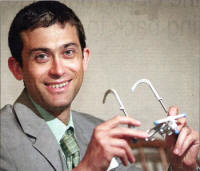
Jenny Monroe talks to Paul Wright, optometrist
 PAUL
Wright, 33, is an Optometrist for Ultralase eye surgery in Belfast. He
lives in Lisburn with his wife Sarah. The newly weds met in Sheffield
where Paul was working at the time. Paul is originally from Derbyshire
and he went to university in Cardiff. He then moved over to Northern
Ireland where Sarah is from and took up a position at the Royal Hospital
before his present role.
PAUL
Wright, 33, is an Optometrist for Ultralase eye surgery in Belfast. He
lives in Lisburn with his wife Sarah. The newly weds met in Sheffield
where Paul was working at the time. Paul is originally from Derbyshire
and he went to university in Cardiff. He then moved over to Northern
Ireland where Sarah is from and took up a position at the Royal Hospital
before his present role.
I'm awake for 6.45am, have breakfast and then cycle to work. It takes me about 35 minutes along the tow path. The first thing I do when I get in is make a cup of tea, check emails and look over what is booked in for the day.
My job is to meet the patients and find out if they are suitable for laser eye surgery. Vision correction from Ultralase can treat nine out of every ten people wearing glasses or contact lenses. It is a safe, effective and increasingly popular vision correction procedure. Sometimes referred to as refractive surgery, laser eye surgery aims to improve your vision and eliminate the need to wear glasses or contact lenses.
The first patient normally arrives at 9am and usually that person will be a follow up patient who has had surgery. I have to check and make sure their eyes are healthy and that they are happy.
Then I move on to the patients who are interested in the surgery and check if they are suitable by looking at the health of their eyes and their vision, advise them on the treatment available and explain what is involved. A scan of the eyes is taken and I look at the optics in detail so I can get an accurate picture. It is is a two-way, relaxed chat. I first check and map the eyes, and then myself and the patient's Personal Advisor will sit and discuss what treatment options are suitable for their unique eyes. This allows the patient to find out more about the benefits, affordability and facts, before making a decision. An average appointment could last up to two hours.
There are two main types of laser eye surgery available at Ultralase: LASIK laser eye surgery and LASEK laser eye surgery. There are also a number of alternative, non-laser vision correction treatments, such as lens implants (known as IOL) and treatment for age-related sight problems.
I enter data into the computer which includes patient details, right prescriptions, how big and deep the flap must be. The paper work must be checked and then the surgeon will chat with the patient to make sure they are happy. I help out in the laser room when the surgeon is doing the laser treatment and at this stage I will be getting the laser ready and helping prepare the room. The patient sees the nurses who puts in drops which numb the eyes. Then the surgeon will carry out the treatment.
It usually takes one minute for each eye and then the patient is left to recover for about 15 minutes. Their eyes are checked and then an appointment is arranged for the next day for them to come in and be examined.
Once a week the staff have a meeting to disc-cuss issues. The team here includes two patient advisors, two opticians and a Manager. Typically I work 9-5pm Monday to Friday and am off at the weekends.
When I get home Sarah and I have dinner and relax. In my spare time I enjoy wall climbing, scuba diving and going to the gym. I enjoy my job as it is a little more challenging than before and what we do here really does make a difference to people's lives.
Ulster Star
19/06/2009
